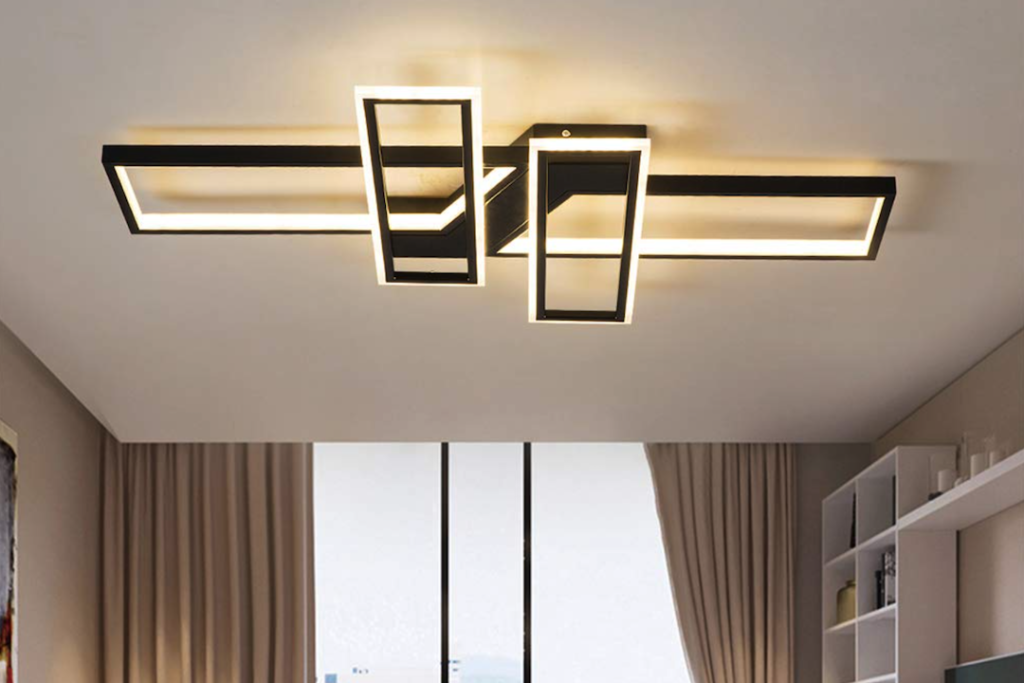In the realm of interior design, the ceiling is often an overlooked canvas, yet it holds immense potential for transforming a living space. Modern geometric living room ceiling design has emerged as a captivating trend that elevates the aesthetic appeal of homes. This design approach utilizes shapes, lines, and patterns to create visual interest and depth, turning an ordinary ceiling into a striking focal point.
The resurgence of geometric patterns in contemporary design reflects a broader cultural shift towards minimalism and abstraction, where simplicity and complexity coexist harmoniously. Geometric designs can range from subtle, understated patterns to bold, eye-catching motifs. They can be employed in various styles, from ultra-modern to eclectic, making them versatile enough to suit diverse tastes and preferences.
The integration of geometric elements into ceiling design not only enhances the visual dynamics of a room but also contributes to the overall ambiance. As homeowners seek to create unique and personalized spaces, modern geometric ceiling designs offer an innovative solution that combines artistry with functionality.
Benefits of Incorporating Geometric Design in Living Room Ceilings
One of the primary benefits of incorporating geometric design into living room ceilings is the ability to create a sense of depth and dimension. Traditional flat ceilings can often feel monotonous, but geometric patterns can break this uniformity, drawing the eye upward and making the space feel larger and more inviting. By using shapes such as triangles, hexagons, or even intricate tessellations, designers can manipulate perceptions of space, creating an illusion of height or expansiveness that enhances the overall room experience.
Moreover, geometric designs can serve as a powerful tool for establishing a theme or style within a living room. For instance, sharp angles and clean lines may evoke a modern aesthetic, while softer curves and organic shapes can lend a more relaxed, bohemian vibe. This adaptability allows homeowners to express their personal style through their ceilings, making them an integral part of the overall design narrative.
Additionally, geometric patterns can be easily paired with various color schemes and furnishings, providing endless possibilities for customization.
Types of Geometric Patterns and Shapes for Living Room Ceilings
The world of geometric patterns is vast and varied, offering numerous options for living room ceilings. One popular choice is the use of chevrons or herringbone patterns, which can add a dynamic sense of movement to the ceiling. These designs can be executed in wood paneling or painted finishes, creating a striking visual effect that draws attention without overwhelming the space.
The angular nature of these patterns can also complement modern furniture styles, enhancing the overall coherence of the room. Another intriguing option is the incorporation of hexagonal shapes, which have gained popularity in recent years due to their versatility and aesthetic appeal. Hexagons can be arranged in a honeycomb pattern or used as individual tiles to create a unique ceiling design.
This approach not only adds texture but also introduces a playful element that can soften the rigidity often associated with geometric designs. Furthermore, circular patterns can provide a counterbalance to sharper angles, offering a harmonious blend that appeals to those who appreciate both structure and fluidity in their living spaces.
Materials and Finishes for Modern Geometric Ceiling Designs
The choice of materials and finishes plays a crucial role in the execution of modern geometric ceiling designs. Wood is a favored option due to its warmth and natural beauty; it can be used in various forms, such as planks or panels, to create intricate geometric patterns. Stained or painted wood can enhance the visual impact while also contributing to the acoustic properties of the room.
For those seeking a more industrial look, metal finishes such as aluminum or steel can be employed to create sleek geometric designs that resonate with contemporary aesthetics. In addition to wood and metal, drywall remains a popular choice for creating geometric ceilings. It allows for seamless integration of shapes and patterns while providing a smooth surface for painting or texturing.
Textured finishes such as stucco or plaster can also add depth and interest to geometric designs, creating shadows that enhance the three-dimensional quality of the ceiling. The use of bold colors or contrasting finishes can further amplify the impact of geometric patterns, making them stand out as key design elements within the living room.
Lighting Options for Enhancing Geometric Ceilings in Living Rooms
Lighting is an essential component when it comes to highlighting modern geometric ceiling designs. The right lighting Ezerliving can accentuate the shapes and patterns on the ceiling while also contributing to the overall ambiance of the living room. Recessed lighting is an excellent choice for illuminating geometric ceilings without detracting from their visual appeal.
By strategically placing recessed lights around the perimeter or within specific geometric shapes, homeowners can create dramatic effects that enhance the architectural features of the ceiling. Pendant lights and chandeliers also offer opportunities for creative lighting solutions. Selecting fixtures with geometric designs can complement the ceiling’s patterns while providing functional illumination.
For instance, a pendant light with angular lines can echo the sharp edges of a chevron-patterned ceiling, creating a cohesive look. Additionally, adjustable lighting options allow homeowners to change the mood of the space by varying brightness levels or color temperatures, further enhancing the impact of geometric designs.
Tips for Choosing the Right Geometric Ceiling Design for Your Living Room
When selecting a geometric ceiling design for your living room, several factors should be considered to ensure that it aligns with your overall vision for the space. First and foremost, assess the size and height of your living room. In smaller spaces or rooms with low ceilings, opting for subtle geometric patterns can prevent overwhelming the area.
Lighter colors and less intricate designs can create an illusion of openness while still adding visual interest. Another important consideration is the existing decor and furnishings within the living room. The geometric ceiling should complement rather than clash with other design elements.
For example, if your furniture features soft curves and organic shapes, consider incorporating rounded geometric patterns into your ceiling design to maintain harmony throughout the space. Conversely, if your decor leans towards modern minimalism with sharp lines and angles, bolder geometric patterns may enhance that aesthetic.
Maintenance and Care for Modern Geometric Ceiling Designs
Maintaining modern geometric ceiling designs requires attention to detail and an understanding of the materials used in their construction. For wooden ceilings, regular dusting and occasional polishing are essential to preserve their natural beauty and prevent wear over time. Depending on the finish applied, it may be necessary to reapply protective coatings periodically to maintain their luster and durability.
For painted or textured ceilings, routine cleaning is crucial to prevent dirt buildup that could obscure intricate patterns. A gentle wash with mild soap and water can help maintain their appearance without damaging the finish. In cases where lighting fixtures are installed within or around geometric designs, ensuring they are free from dust will enhance their effectiveness in illuminating the ceiling’s features.
Regular inspections for signs of wear or damage will also help maintain the integrity of the design over time.
Bringing Modern Geometric Design to Your Living Room Ceilings
Incorporating modern geometric design into living room ceilings offers an exciting opportunity to redefine interior spaces creatively and artistically. With various patterns, materials, and lighting options available, homeowners can tailor their ceilings to reflect personal style while enhancing functionality. As this trend continues to evolve, it invites individuals to explore new dimensions in home design—transforming ceilings from mere structural elements into captivating works of art that elevate everyday living experiences.




More Stories
Stylish Bowl-Shaped Living Room Lamp
Modern Bowl-Shaped Table Lamp for Your Living Room
Transform Your Space with a Living Room Waterfall Wall Lamp